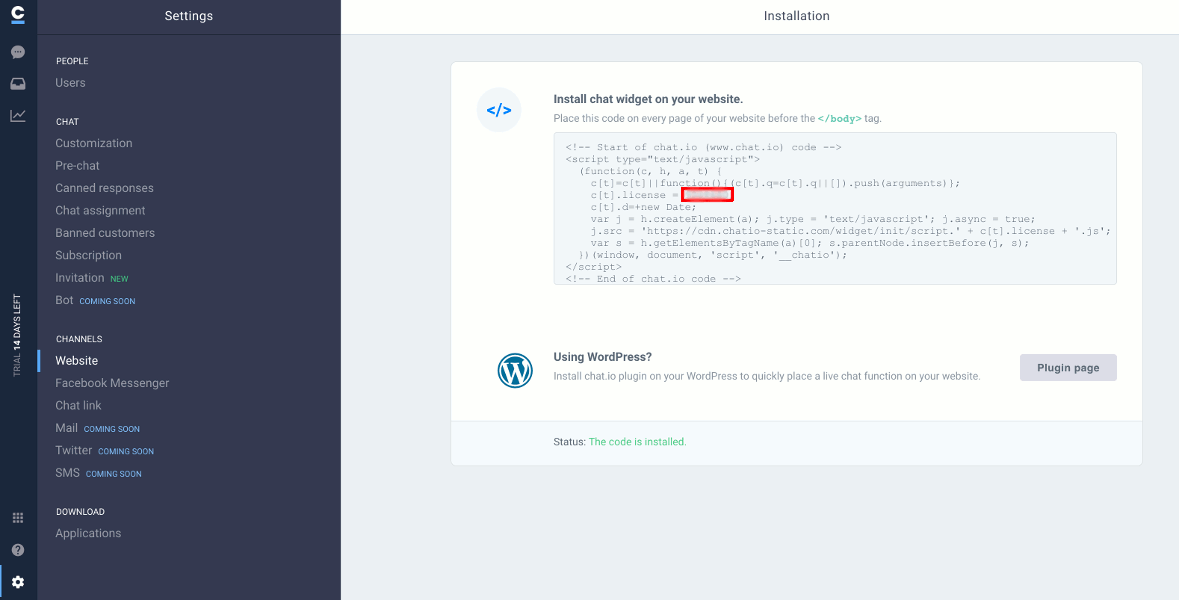This is a React Native component to easily add chat.io widget to your application.
To use chat.io in your React Native application, you will need the following:
If you already have a chat.io account, get your license_id here.
If you don't have an account, you can create one here.
- Log in to chat.io Developers Console.
- Go to "Apps" and add a new application (select the "Web app (frontend, eg. JavaScript)" type).
- When the app is created, go to Apps -> Authorization for your Client ID and Redirect URI.
To import chat.io for React Native, run the following command:
npm install react-native-chatio --saveHaving imported chat.io for React Native, put it in your render method:
import ChatIO from "react-native-chatio"
...
<ChatIO
clientId="client_id"
redirectUri="redirect_uri"
license={license_id}
/>Chat bubble is the round icon (chat trigger) in the bottom right corner of the screen.
You can control the position of the bubble with bubbleLeft and bubbleTop props:
<ChatIO bubbleLeft={0} bubbleTop={0} license={your_license_id} />By default, the bubble component is draggable and movable. You can disable this option by sending movable prop with false value:
<ChatIO movable={false} license={your_license_id} />You can change the color of the bubble by passing bubbleColor prop:
<ChatIO bubbleColor='red' license={your_license_id} />If you don't like the default bubble, you can send bubble prop with your own component:
<ChatIO license={your_license_id}
bubble={
<View style={{ width: 60, height: 60, backgroundColor: 'green' }} />
}
/>This module uses react-native-gifted-chat for chat UI.
You can customise your chat widget by sending props to ChatIO component (like you would normally do with GiftedChat component).
For example, if you want onPressAvatar to show agent's details, you can do it like this:
<ChatIO license={your_license_id}
onPressAvatar={ info => console.warn(info) } />You can find all props in the official react-native-gifted-chat documentation.
This module uses Chat.io Customer SDK. All methods are described here.
To begin with, get your chat reference using onLoaded callback:
<ChatIO
onLoaded={ref => this.chat = ref}
onChatStarted={ chat_id => this.chatId = chat_id}
/>With this reference you can, for example, get full chat history:
const history = this.chat.getChatHistory(this.chatId);Learn more about handling chat history here.
Note: Some methods require the current chat_id to work. You can get it with onChatStarted callback.
| Name | Note |
|---|---|
| destroy | This method clears any held resources, removes all listeners and disconnects from the network. After using this method you won’t be able to use the destroyed SDK’s instance. |
| disconnect | Disconnecting user from current chat. |
| getChatHistory | This method facilitates loading more history events. |
| sendMessage | Sending message to current chat. More info here. |
| setSneakPeek | Sets the internal sneak peek value. It will be sent to the server only if the target chat is active and only once per 2 seconds (it’s throttled). |
| startChat | Starting chat. |
| updateCustomer | Updates info about customer. More info here. |
You can listen for emitted events by subscribing to them (using on method) with your custom JavaScript function.
All events are described here.
| Name | Note |
|---|---|
| connected | Executes when user connect to Chat.io. |
| connection_lost | Executes when user lost connection. |
| connection_restored | Executes when user's connection is restored. |
| disconnected | Executes when user disconnects from Chat.io. |
| user_joined_chat | Executes when joining chat. |
| user_left_chat | Executes when user left chat. |
| user_is_typing | Executes when user is typing. |
| user_stopped_typing | Executes when user stopped typing. |


